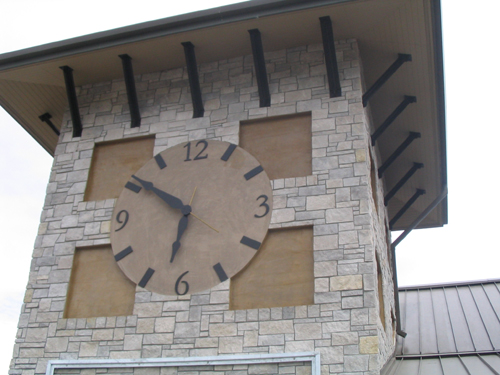Thin Brick and Thin-Cut Stone Take on Full-Dimension Masonry Products
In hot weather, type N may be used for better workability. Because of its high lime content, Type N has excellent workability although its strength is not that of Type S.
Masonry cement is not recommended for thin veneer. In all cases, it is prudent to follow the manufacturer's recommendations when making mortar selections for any application.
Thin veneer units should not be installed when ambient temperatures are below 40 degrees Fahrenheit unless cold weather masonry construction requirements per ACI 530-05 Section 1.8C are followed.
Wood or Metal Frame Applications. Installation should include a water-resistive vapor-permeable barrier with a performance at least equivalent to two layers of grade D paper, a water-vapor permeable paper. Corrosion resistant metal lath and corrosion resistant lath attachments should be installed in accordance with ASTM C1063 every 6 inches oncenter. Metal lath should conform to ASTM Specification for MetalLath C 847. A 3/8- to ½-inch thick scratch coat should be applied to the metal lath. A ¼-inch notched trowel should be used, leaving all notches horizontal. The scratch coat should be left to cure a minimum of 24 hours, and the thin stone units applied in a 1/2-inch- to ¾-inch-thick setting bed over the scratch coat. The entire back surface of the rock must be covered with mortar. Total mortar thickness behind thin rock units should not exceed 1 ¼ inches. The rocks should set for 24 hours before grouting begins. A grout mixture that is the same mortar type should be used.
|
Masonry Applications.Thin rock may be installed directly to new concrete masonry units or concrete surfaces that are free of any form release agents. No metal lath or water-resistive barrier is required with these applications. Previously exposed surfaces that have been stained, sealed, painted, or treated should be sand blasted to insure proper mortar bond. Thin rock units shall be set in a ½-inch to ¾-inch setting bed of type S mortar. Thin rock units should be fully buttered on the back side and set in place. For best results, the rock should be set for 24 hours before grouting. The grout mixture should be the same mortar type and tooled when thumbprint hard.
Compared to full dimension stone or masonry veneer, natural thin veneers offer substantial benefits, particularly in terms of engineering, shipping and installation.
Interior Applications.Most interior stone veneer installations are not exposed to moisture. Type S or Type N or special epoxy adhesives approved for thin stone applications should be used to adhere the thin stone to the backup wall. Suitable backup wall types include concrete, concrete masonry units, brick and cementitious board.
A thin bed of adhesive or mortar should be applied over these backup walls using the flat side of the trowel, followed by an additional coat of adhesive using the notched side of the trowel. The stone can then be placed. If needed, the back of the stone can be covered with adhesive to achieve correct coverage and bedding. Once the stone has been firmly pressed into the adhesive bed, a soft rubber mallet can be used to set the stone.
Exterior Applications. Thin rock and thin brick follow roughly the same steps for exterior application, with an important qualifier. While durability is a property of natural stone and brick, not every type of stone or brick will perform well on exterior applications in all climates. Particularly in areas that experience extremes of weather, exterior applications should only be specified for thin veneer that has been properly tested under the prevailing climatic conditions.
In some exterior applications, thin stone and thin brick can be installed directly on concrete block, or on a mortar bed over metal lath. Thin veneer applied to masonry, stucco or block that is clean and untreated does not require a weather resistant barrier or metal lath.
Stone veneer is not recommended for exterior installation with open joints in climates with freeze/thaw weather cycles. Dry stack installation can be used for interior installations or warm climates where it does not freeze.
In exterior applications where water penetration may be problematic, a moisture barrier, and sometimes a weeping material, are often critical. A weather-resistant barrier should be used to cover the wall, overlapping the joints four inches. The metal lath should be installed over the barrier using galvanized nails or screws driven into studs. The lath will feel smooth to the hand as it moves upwards, and rough as it moves downwards. The lath should be one inch from the finished edges.
For a 8,200-square-foot home in Evergreen, Colorado, Colorado Master Builders specified thin stone veneer for the interior, exterior and for an iconic curved wall that slopes up through the project. "We selected a variety of stone that matches the existing rock on the site," says Kazenske, who notes that for exterior use, the manufacturer's specifications were followed. "The installation wasn't any more complicated than what would be expected for an exterior application involving conventional masonry, and in a lot of ways made the details much easier."










